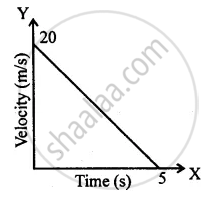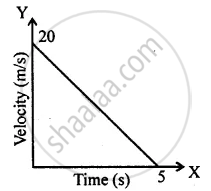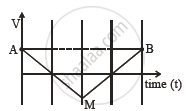Advertisements
Advertisements
Question
Given on th e side are a few speed - time graphs for various objects moving along a stra ight line. Refer below figure. (a), (b), (c) and (d).
Which of these graphs represent
(a) Uni form motion
(b) Motion with speed increasing
(c) Motion with speed decreasing and
(d) Motion with speed oscillating.?
Solution

(i) In speed time graph uniform motion is given by a straight line parallel to x axis so figure (a) denotes the uniform motion.
(ii) In speed time graph motion with increasing speed is shown by straight line with positive slope so figure (c) denotes the motion with speed increasing.
(iii) In speed time graph motion with decreasing speed is shown by straight line with negative slope so figure {b) denotes the motion with speed decreasing.
(iv) In speed time graph motion with oscillating speed is shown by zigzag line so figure {d) denotes the motion with speed oscillating.
APPEARS IN
RELATED QUESTIONS
The velocity-time graph for part of a train journey is a horizontal straight line. What does this tell you about the trains velocity.
The velocity-time graph for part of a train journey is a horizontal straight line. What does this tell you about its acceleration ?
Draw a displacement-time graph for a boy going to school with uniform velocity.
Draw a velocity-time graph for the free fall of a body under gravity starting from rest. Take g = 10m s-2
Multiple choice Question. Select the correct option.
In the velocity-time graph, the acceleration is

Multiple choice Question. Select the correct option.
The distance covered in the adjoining velocity-time graph is :

From the velocity – time graph given below, calculate Distance covered in the region ABCE.

What does the slope of speed-time graph indicate?
Sketch the shape of the velocity-time graph for a body moving with:
Uniformly velocity
If the velocity-time graph has the shape AMB, what would be the shape of the corresponding acceleration-time graph?

